Special Report
50 Key Ways Women Can Improve Their Health

Published:

Throughout history, women have had to endure childbirth and take care of the home and children while also working outside the home. It is women’s roles that have ensured societal stability and the long-term development of nations.
While this may have provided women some benefits — they are better at multitasking, for example — it has also contributed to issues affecting women’s health. Women have faced years of discrimination within the health care system, and it’s for this reason they need to be extra aware of potential health issues.
24/7 Tempo discussed women’s health issues with doctors and reviewed information from health organizations such as the National Institutes of Health to compile a list of some of the most important health tips women should be aware of.
According to the World Health Organization, women worldwide outlive men. In the U.S., female life expectancy exceeds male by 5 years. This partially reflects women’s greater attentiveness to their health. Women are more likely to see doctors, report all symptoms, and manage chronic conditions like depression, thyroid dysfunction, and certain cancers. For a different point of view, take a look at the 50 health tips every man should know about.
As childbearers, women must consider reproductive health issues. Hormone fluctuations with age also contribute to women’s health risks. However, healthy lifestyles – nutritious diets, fitness, and weight management – can mitigate these risks across life stages.
Click here to read about the 50 health tips every woman should know

1. Pay attention to your mental health
Depression, anxiety, and somatic complaints are three disorders, which more women are diagnosed with, according to the World Health Organization. Unipolar depression, which is a condition of persistently depressed mood or loss of interest in activities, is twice as common in women as it is in men. It is also predicted to be the second leading cause of global disability burden of both genders by 2020. The incapacity associated with mental illness is most heavy in people, most of whom are women, who experience three or more disorders at the same time.
[in-text-ad]
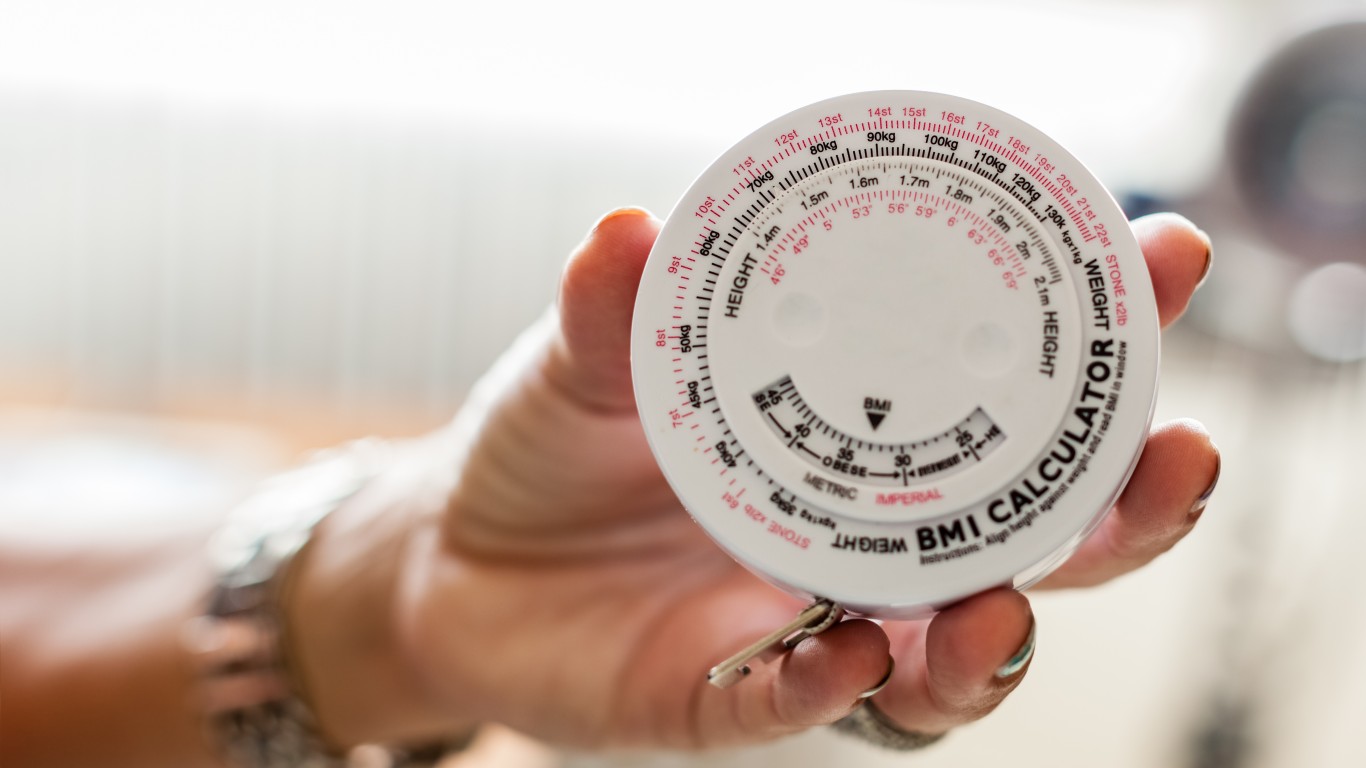
2. Don’t pay so much attention to the BMI number
BMI is shorthand for body mass index and is calculated based on a person’s height and weight. BMI levels and broken down into four: underweight, normal, overweight, and obese. Though some in the medical field consider it a fine gauge for obesity, others think it is obsolete. Critics such as Scott Kahan, director of the National Center for Weight and Wellness, say BMI doesn’t capture the full picture of the person. He says a person may be overweight but their cholesterol and blood pressure levels might be good.
It’s a simple number that doesn’t take into consideration where, for example, most of the body fat is located. While two people of the same height may weigh the same, and therefore have similar BMIs, if most of the fat in one is on the belly, he or she may have increased risks of certain conditions. Because abdominal fat is deeper and surrounds the internal organs, it may increase the risk of heart disease and diabetes. BMI is still measured by many doctors to assess weight, and this is how the average weight of men and women has changed since the 1970s.

3. Know the signs of an eating disorder
Eating disorders have the highest mortality rate of any mental illness, according to the National Eating Disorders Association. It breaks down signs of eating disorders — such as anorexia nervosa, bulimia nervosa, and binge eating — into two categories: emotional and behavioral and physical. Emotional and behavioral symptoms include: preoccupation with weight, food, and dieting; discomfort eating with others; mood swings; being overly concerned about body image; withdrawing from friends. Physical symptoms include: fluctuations in weight; menstrual irregularities; trouble focusing; dizziness and fainting; sleep problems; cuts and calluses on finger joints (from induced vomiting).

4. Know the risks of heart disease
Only about 56% of women are aware that heart disease is the No. 1 killer of women in the United States, according to the CDC. One in about five female deaths were attributed to heart disease in 2017. Heart disease is the No. 2 killer, after cancer, only among Hispanic and Asian or Pacific Islander women. Activities and conditions that increase the risk of developing heart disease include eating an unhealthy diet rich in processed and fatty foods, being physically inactive, having diabetes, being overweight, and drinking too much alcohol. In general, one in every four deaths in the United States is caused by heart disease — and these are the states with the most heart disease.
[in-text-ad-2]
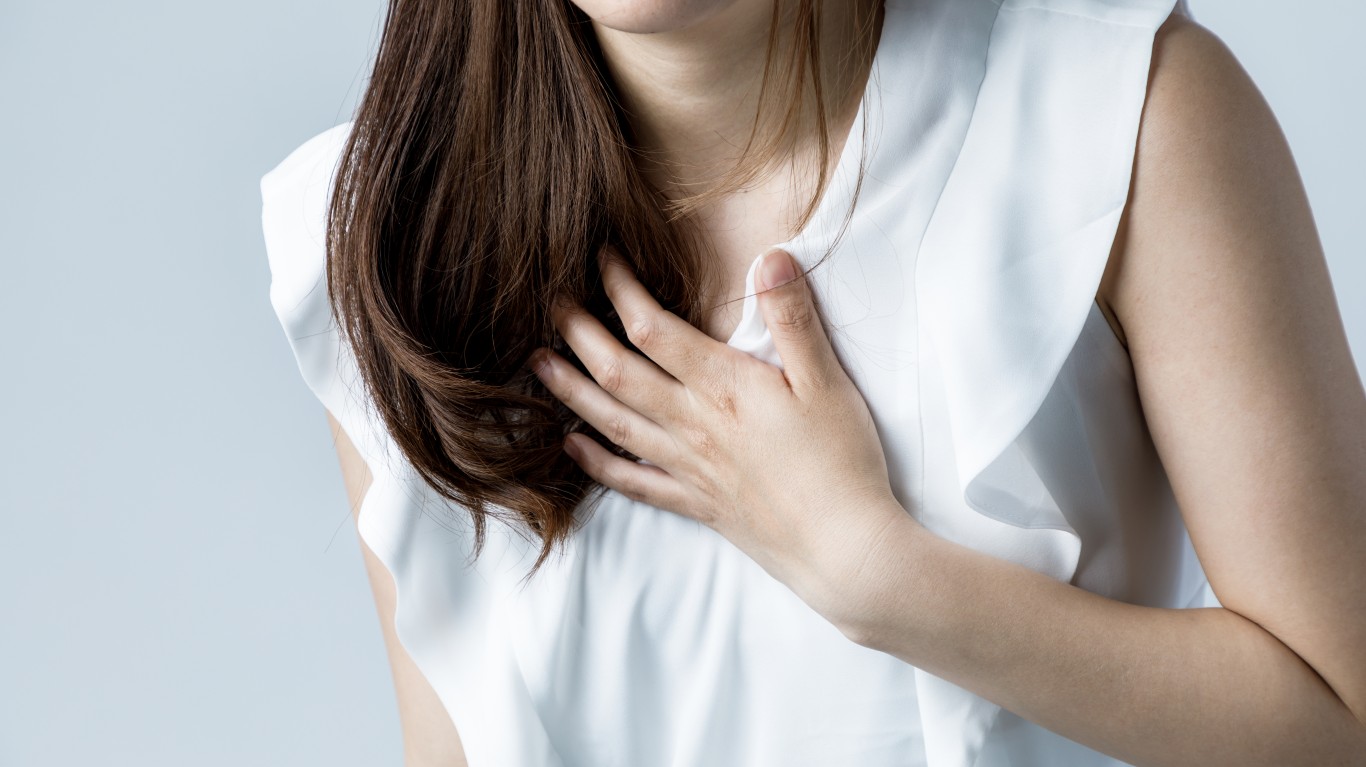
5. Know the symptoms of a heart attack in women
A major difference in heart attack symptoms in men and women is chest pain — women may or may not experience chest discomfort, according to the American Heart Association. While angina (chest pain caused by restricted blood flow to the heart) might be a missing symptom in men too, it is far more common in women — and when chest pain occurs, it is often not severe. Women are more likely to experience vague heart attack symptoms such as stomach, neck, and jaw pain, nausea, sweating, dizziness, and unexplained fatigue.

6. Never disregard stomach pain
Most of the time stomach pain is caused by indigestion, constipation, a virus, or gas. But stomach pain or discomfort can also be a sign of heart attack in women, according to the American Heart Association. If this is the case, however, the pain will often be intense and will be accompanied by other symptoms such as jaw pain, shortness of breath, lightheadedness, or nausea. This is why stomach pain and other seemingly vague symptoms should never be ignored, even though most people do.
[in-text-ad]
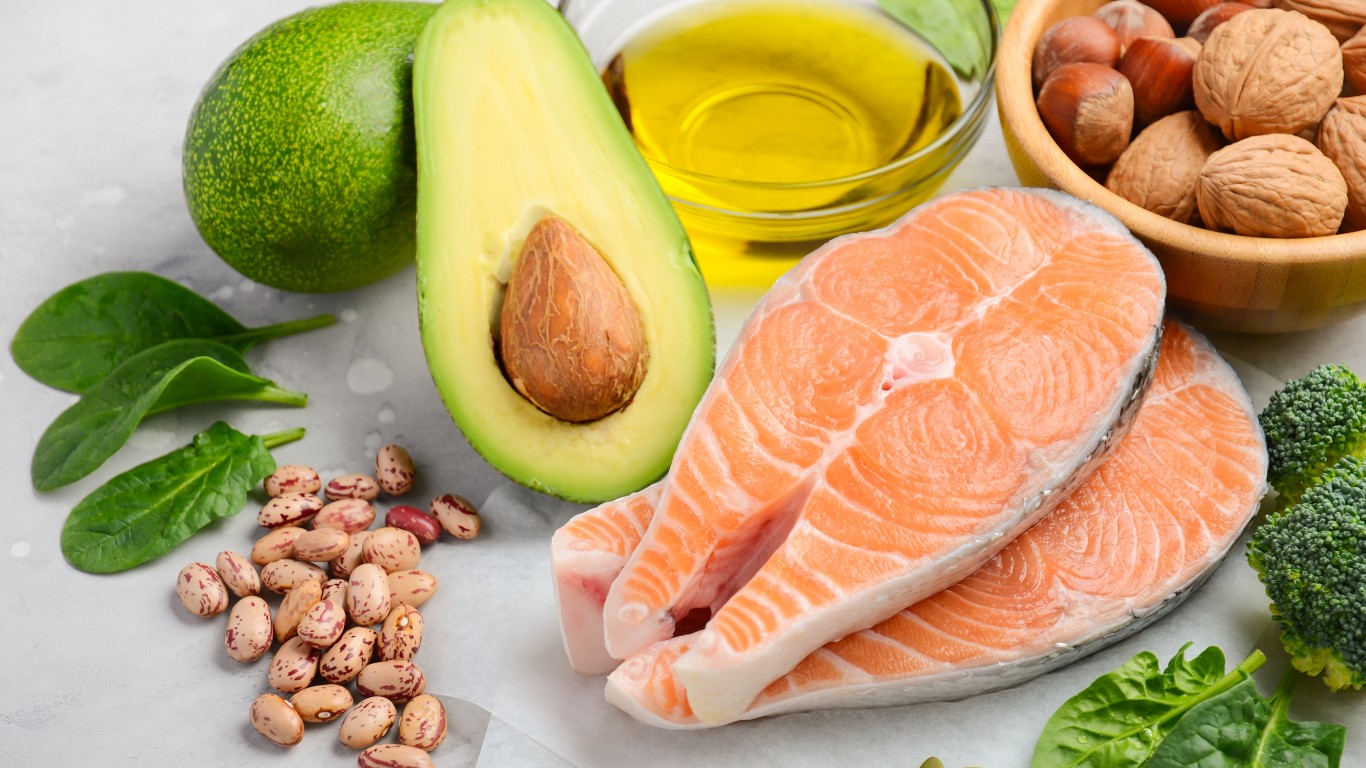
7. Eat more healthy fats
Not all fats are bad for you. Monounsaturated fat is found in olive and canola oil and researchers consider it to be healthier. Polyunsaturated fats are essential to normal body functioning. It comes mainly in two forms: omega-3 and omega-6. The body doesn’t produce them so people have to get them from foods. Omega-3, found in fish, nuts, plant oils, and some fortified foods, is recommended for women who are pregnant because it is crucial to brain function development. There is evidence that higher levels of omega-6 promote weight fat.

8. Check for breast and ovarian cancers
Check for hereditary breast and ovarian cancer syndrome (HBOC). Women are urged to get a diagnosis for HBOC if there have been multiple cases of breast and ovarian cancer on one side of the family over several generations. In families with four or more cases of breast cancer diagnosed before the age of 60, the chance of HBOC is about 80%.
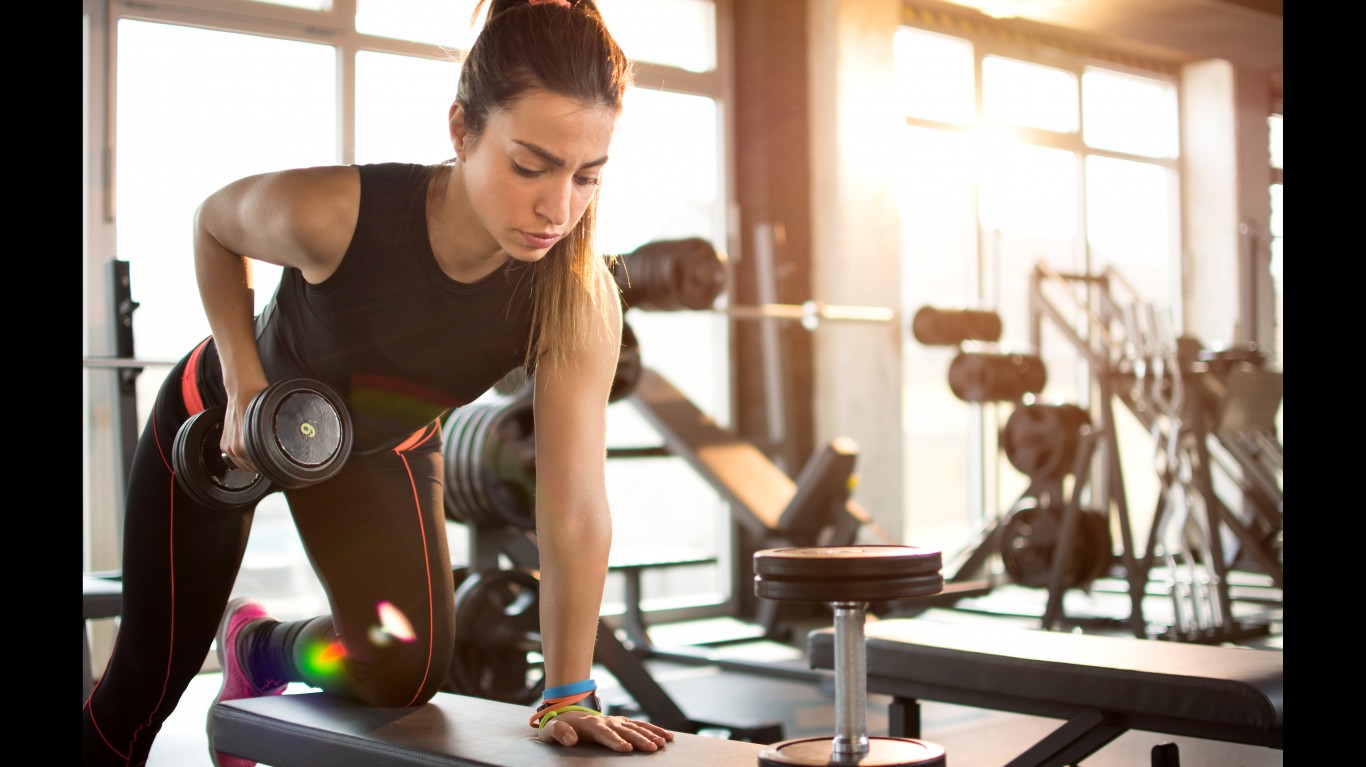
9. Don’t forget strength training
Cardio exercise — whether it is using the treadmill or taking a dance class — helps shed the pounds, but strength training is important because this is how you build muscle. The body starts to lose muscle mass after the age of 30, and inactive people can lose up to 5% of muscle mass over 10 years. Any loss of muscle lessens one’s strength, which increases the risk of falls and fractures.
[in-text-ad-2]

10. If you want to get pregnant…
Women who want to get pregnant might find it helpful to track their menstrual cycle, which would give them an idea when they’re most fertile. In the average 28-day menstrual cycle, there are six days when a woman can get pregnant — the day one of her ovaries releases an egg, or ovulation, and the five days before. Because the length of the menstrual cycle can vary even from month to month, it’s helpful to track it over a period. Once an average is determined, subtract 18 days from the length of the shortest cycle, and that would be the first day you might be fertile. Then deduct the 11 days from the longest cycle, and that would be the last day you’re likely to still be fertile. Having sex between those dates improves chances of getting pregnant.

11. Avoid fad food trends
Some food trends — such as the raw fish poke dish or adding turmeric, which is derived from the root of a plant of the ginger family and has antioxidant properties, to lattes and soups — get the thumbs-up from nutritionists. But not all food trends get their approval. Juice cleanses are criticized by nutritionists because they don’t provide enough nutrients and are an all-liquid diet that will leave you craving for food later. The natural sweetener agave is high in fructose content, and when it’s consumed in high amounts might cause problems for the liver. The biggest food fads of the past 50 years may surprise you.
[in-text-ad]

12. Eat sitting down
Adult women’s calorie consumption declined when they were eating while seated, according to a 2007 study published in the Journal of the Academy of Nutrition and Dietetics. This is because women who were seated tended to eat more slowly. Studies have shown that it takes about 20 minutes for your brain to recognize that you are full. Eating more slowly while seated helps the brain get that message. Just don’t eat these foods that you only think are healthy.
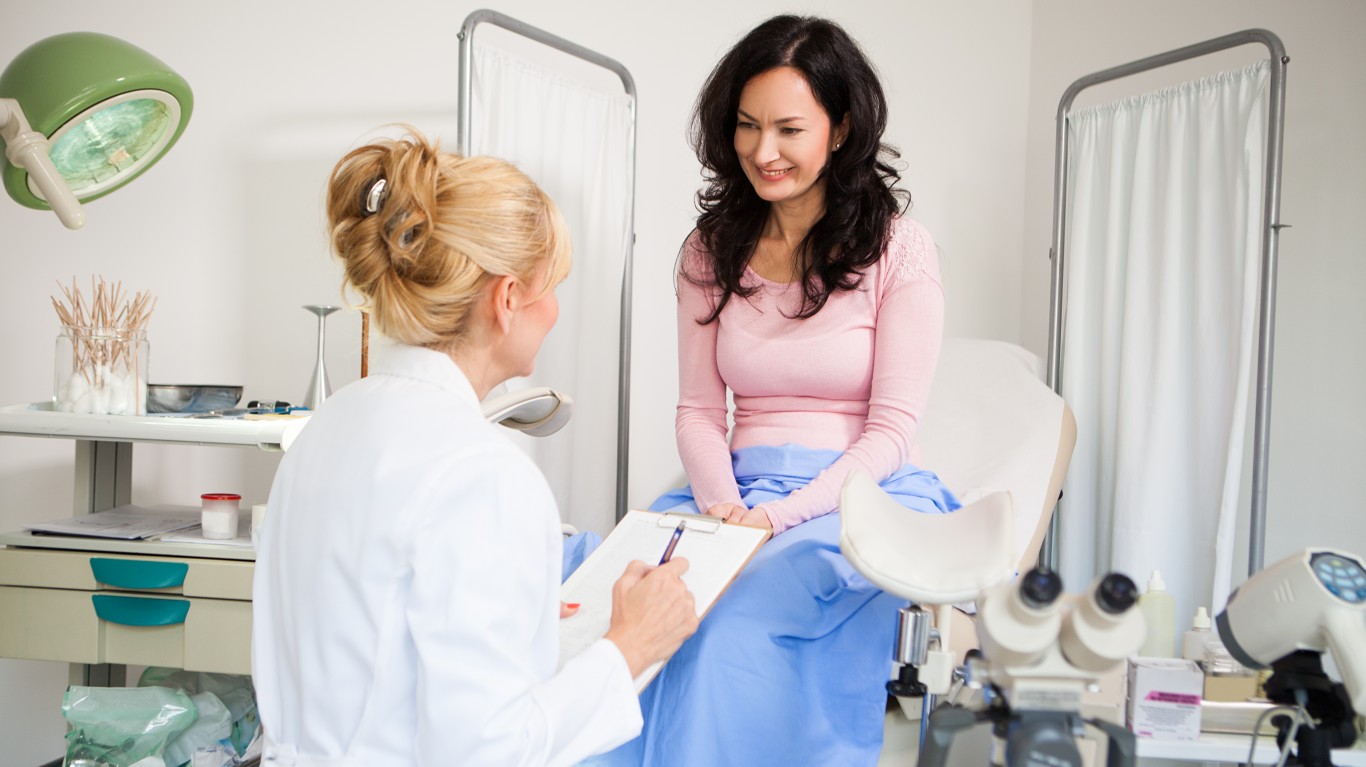
13. Get a Pap smear every 3 years
About 12,000 women in the United States are diagnosed with cervical cancer each year, and a third of them die from it. The current recommendation for women age 21 and older is to get a Pap smear every three years to screen for cervical cancer, according to the American College of Physicians. Starting at age 30, women can lengthen the screening interval to five years if they do a combination of Pap smear and test for human papillomavirus (HPV).
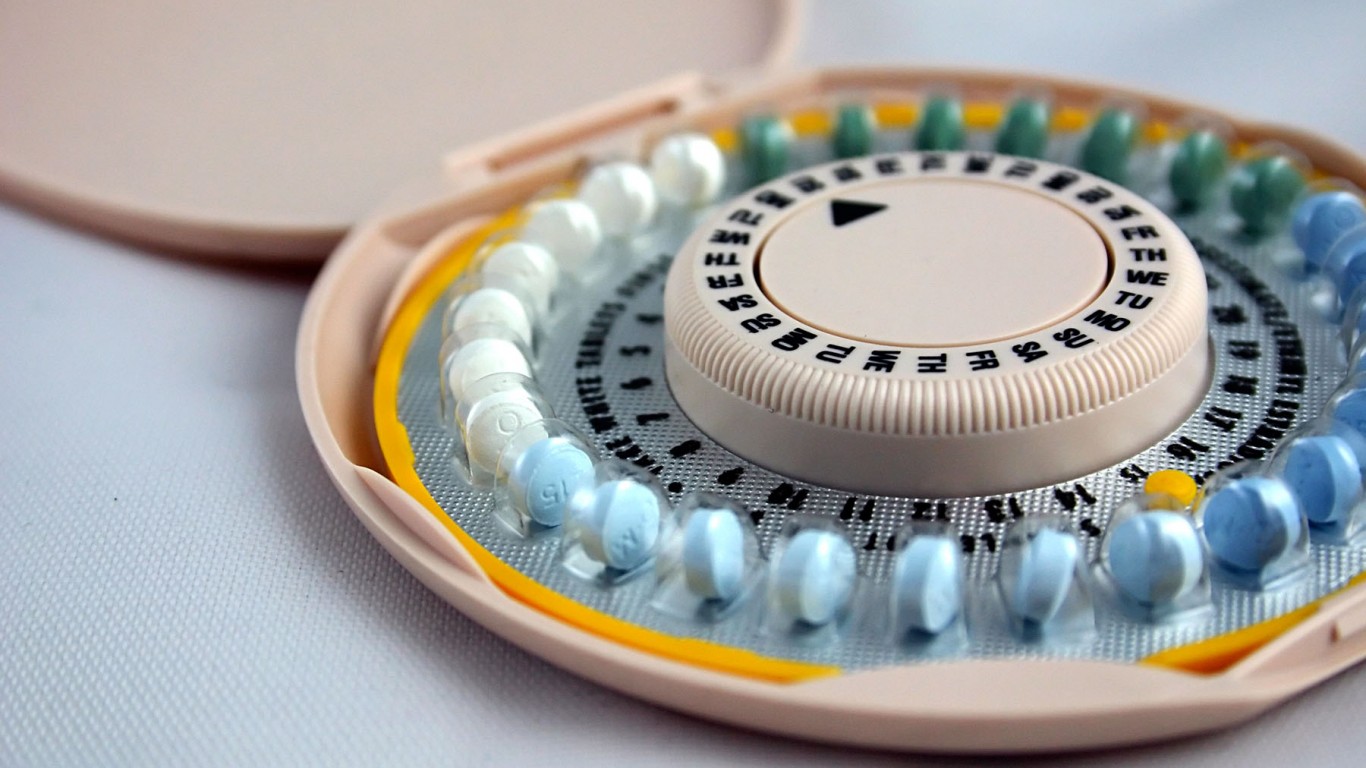
14. Don’t shun birth control pills
In addition to preventing pregnancy, birth control pills have many other health benefits. The pill can help to control acne, lighten menstrual periods and mitigate menstrual cramps, and better manage premenstrual syndrome. The pill can also reduce or help prevent cysts in breasts and ovaries, bone thinning, endometrial and ovarian cancers, and infections in the ovaries, fallopian tubes, and uterus.
[in-text-ad-2]
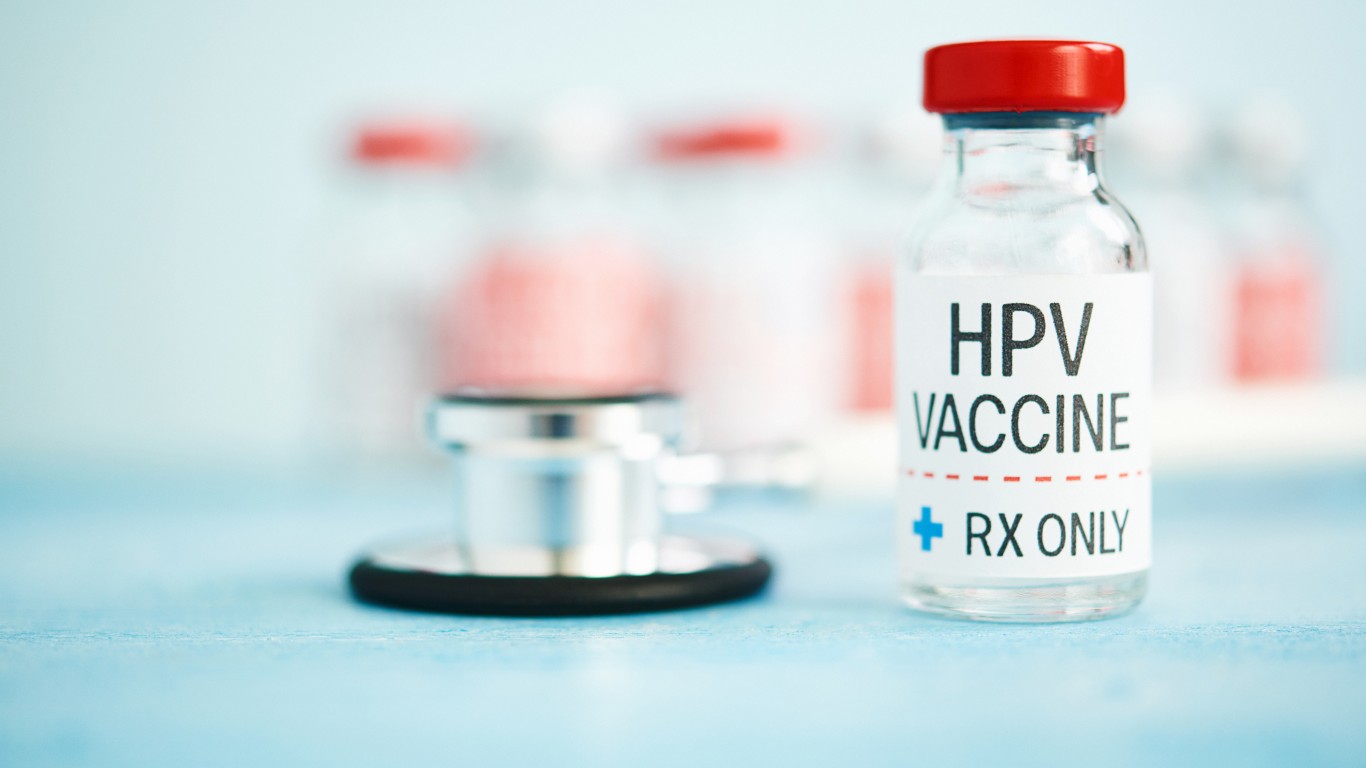
15. Consider the HPV vaccine
Human papillomavirus, also known as HPV, is a virus passed among sexually active people, mostly in the late teens and early 20s. Some types of HPV can cause cervical cancer in women. Each year, about 12,000 women in the United States are diagnosed with cervical cancer and 4,000 women die from this disease. The CDC recommends that girls 11 and 12 years old get two doses of HPV vaccine, one within six to 12 months of the first. The vaccine is also recommended for girls and women who have not yet been vaccinated or completed the vaccine series through age 26 years. The HPV vaccine is recommended for young men through age 21.

16. Get genetic testing done if you can
Tests for inherited genetic mutations may be helpful to women as they can provide information on what they can do to minimize the risk of developing certain cancers such as breast and ovarian, according to the National Cancer Institute. However, genetic testing is a controversial topic in the medical community. Earlier this year, the U.S. Preventive Services Task Force said primary care providers should screen women who have family members with breast, ovarian, tubal, or peritoneal cancer. Those with positive results should get genetic counseling for BRCA1 and BRCA2 mutations. These genes produce tumor suppressor proteins that help repair damaged DNA. When one or both genes are mutated or somehow changed, the protein does not function correctly and the DNA damage may not be repaired, which may eventually lead to cancer. These are the common cancers in women.
[in-text-ad]
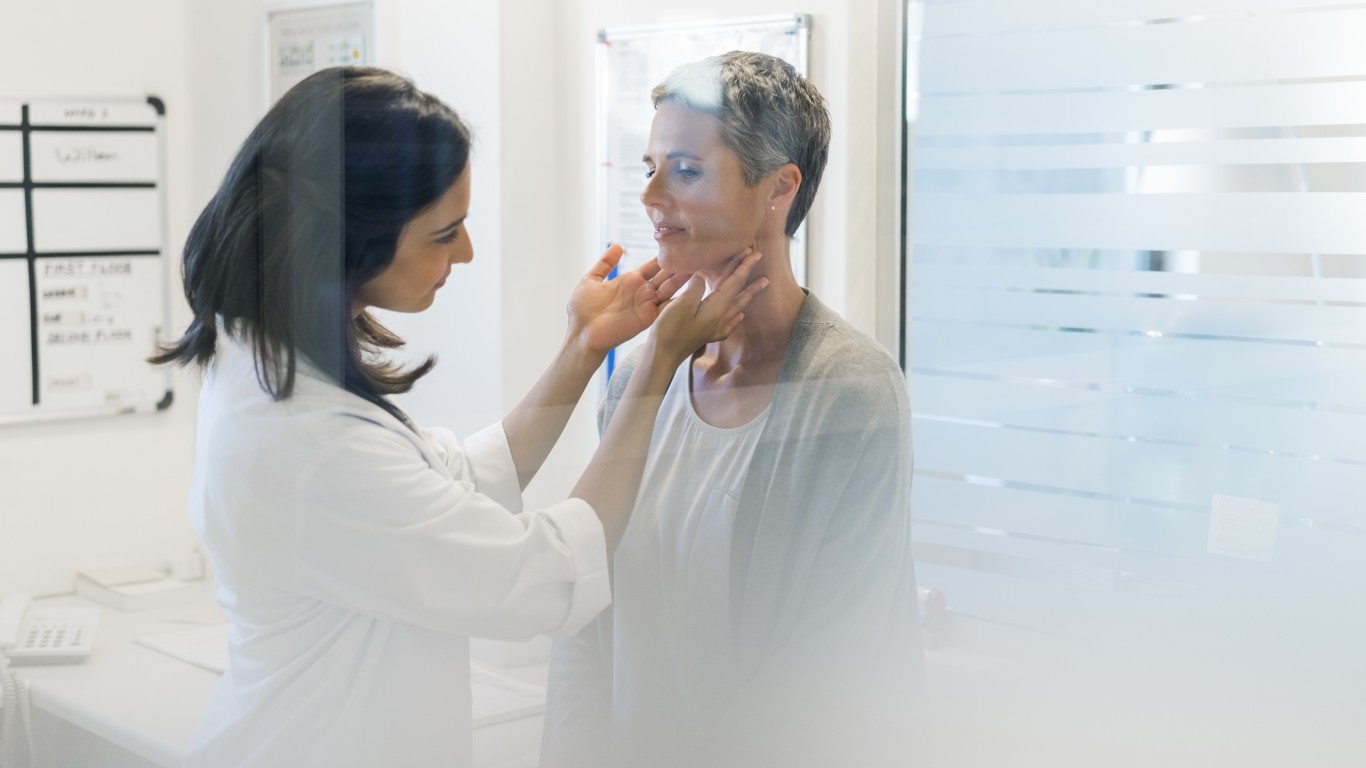
17. Check your thyroid
The thyroid, a gland 2 inches in size, helps to regulate the metabolism. Women are more likely than men to have thyroid problems. Women who have an untreated thyroid disease may be at an elevated risk of cardiovascular disease, osteoporosis, and infertility, according to the American Thyroid Association. Symptoms of an underactive thyroid (hypothyroidism), which results in low levels of the hormone, are fatigue, weight gain, light-headedness, cold hands, and dry skin. Pregnant women with undiagnosed or untreated hypothyroidism are at higher risk of miscarriage, preterm delivery, and developmental problems in their children. Symptoms of hyperthyroidism are somewhat the opposite and include weight loss, trouble sleeping, and irritability. Most thyroid diseases are life-long conditions that can be managed with medical attention. Dysfunctional thyroid is serious. It is one of 20 things that can lead to memory loss.

18. Don’t skip breakfast
The American Heart Association says some studies show that people who don’t eat breakfast are more likely to be obese, have diabetes, use tobacco, not exercise regularly, not get the recommended amount of nutrients, and eat more sugar during the rest of the day. The association suggests having muffins with healthful ingredients; starting your day with oatmeal; taking a smoothie containing your favorite fruits, vegetables, yogurt, or low-fat milk; or putting low-fat cottage cheese or nut butter on a whole-grain waffle.

19. Eat a lot of foods with vitamin C
Your skin contains high amounts of vitamin C, and it’s important for women to eat food rich in vitamin C. That vitamin supports functions such as generating collagen synthesis, which helps the body produce antioxidant protection against ultraviolet-caused damage. Production of collagen, which is basically what keep the skin healthy and glowing, decreases with age, which is why the skin gets wrinkles. Eating fruit and vegetables is connected with good health, and getting more vitamin C helps heal wounds and reduces formation of scar tissue.
[in-text-ad-2]

20. Sleep more
British sleep science researcher Dr. Jim Horne says women need 20 minutes of sleep a night more than men because they muti-task more than men and use their brain more. And the more you use your brain, the more sleep you need. Insufficient sleep, which has been linked to diabetes, heart problems, obesity, and depression, increases mortality risk, according to Dr. Mayank Shukla, a sleep medicine specialist in New York. If you’re not getting enough sleep, the National Sleep Foundation recommends you get more exercise, get into a regular schedule of going to bed and waking up, and limit your caffeine and alcohol. These are just some of the tips for a better night’s sleep.

21. Ask questions at the doctor’s office
While they are at the doctor’s office, women should ask their primary care doctor about any screening tests they should schedule, such as for a mammogram. They are encouraged to discuss fertility issues if there are any and seek an update on medications they are taking. They should inform doctors if they are experiencing pain. An important question to ask is if they are of healthy weight. More men then women are overweight or obese, but the condition poses the same risk for both sexes, including diabetes, heart disease, sleep apnea, and cancer.
[in-text-ad]

22. Strengthen your core
Body fat in women after menopause tends to accumulate in the belly area as estrogen levels decline — the hormones appears to play a role in the body fat distribution. Doing cardio, weight lifting, and core work can help prevent fat buildup in the abdominal area. These are also some of the best ways to keep the weight off if you’re over 40.

23. Dance more to relieve stress
Dancing is more than just a recreational activity. It boosts heart and lungs; strengthens muscles; improves agility and motor skills; helps physical endurance; and raises your confidence. Some studies show that dance helps reduce stress and increases levels of the hormone serotonin, which is also known as the “happy hormone.” Men and women react differently to stress, but women are more likely to report physical and emotional symptoms, according to the American Psychological Association. Stress is also on the rise more among women than men.

24. Know your alcohol limit
For women, heavy drinking is considered to be eight drinks a week, according to the Centers for Disease Control and Prevention. While men are more likely than women to binge drink, women are more vulnerable than men to alcohol-related organ damage, according to the National Institute on Alcohol Abuse and Alcoholism. This is due to the body’s structure and chemistry. Women absorb more alcohol and take longer to process it. Therefore, the immediate effects of alcohol last longer in women. Health concerns associated with excessive drinking include cirrhosis of the liver, memory loss, damage to the heart muscle, and cancer. People in some states consume more alcohol than others — these are America’s drunkest (and driest) cities.
[in-text-ad-2]

25. Put on some sunscreen lotion
Not wearing sunscreen regularly is one of the most common mistakes people make when it comes to skin care, according to Dr. Heather Richmond, a dermatologist at the Dermatology and Laser Surgery Center in Houston, sees. Wearing a daily sunscreen is the most important thing you can do to slow down the aging process as well as to reduce the risk of skin cancer, she noted. Women under 49 have a higher probability of developing melanoma than any other type of cancer, except breast or thyroid cancer, according to Johns Hopkins Medicine. Until the age of 49, more white women develop melanoma than white men, but more men die from it. Skin cancer is among the most common types of cancer in men and women.

26. Test your cholesterol
Women who have been through menopause should pay special attention to their cholesterol. The female sex hormone estrogen seems to boost the HDL “good” cholesterol, but that changes at menopause. Total and LDL “bad” cholesterol rise, and HDL cholesterol falls. High triglyceride levels in the blood can increase your risk of heart disease, including heart attack and stroke. Exercising and eating a healthy diet may reduce the risk of high cholesterol levels. Healthy eating was at its lowest level in 2016, and these are the cities with the worst diets in America.
[in-text-ad]
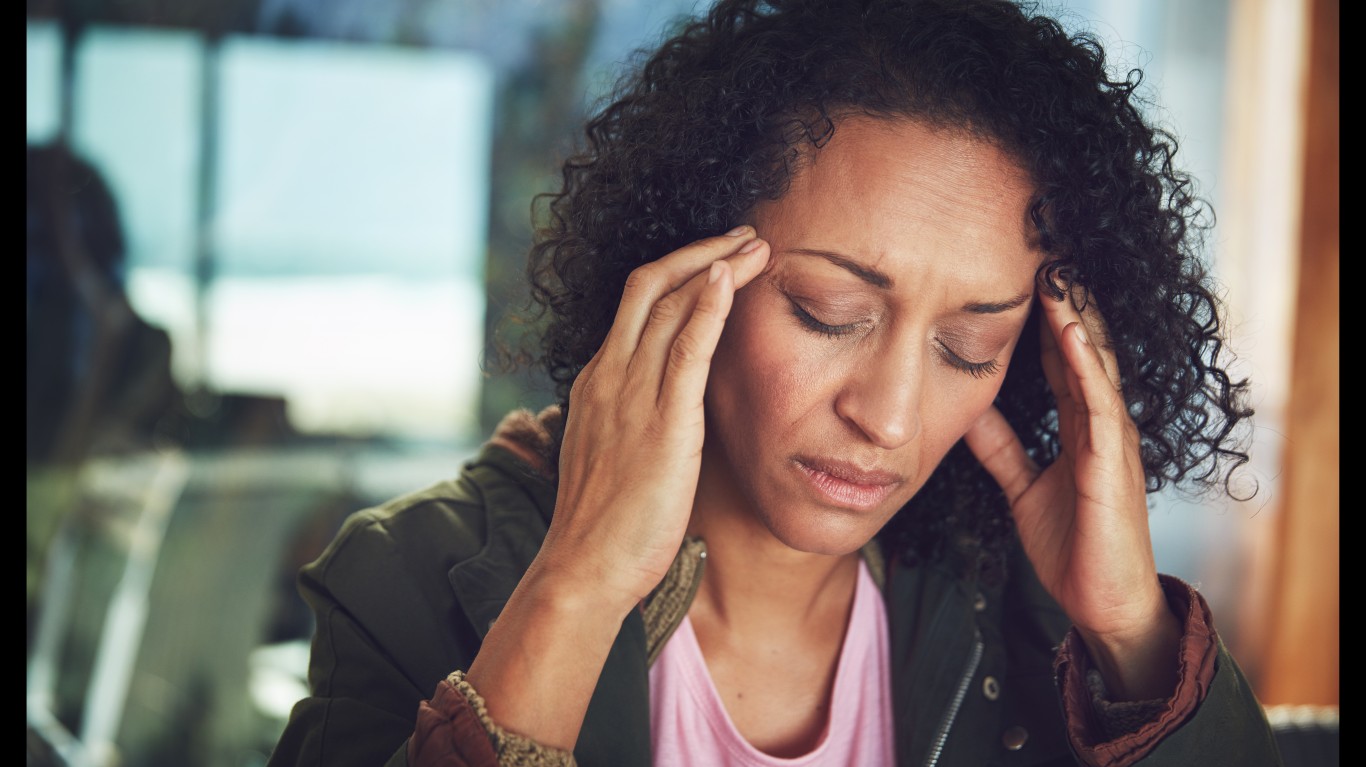
27. Know how to relieve migraines
About three of every four people who have migraines are women, according to the U.S. Department of Health and Human Services. They are most common in women between 20 and 45. Migraine, an intense pain in one or both sides of the head, is the most common type of headache for which people go to see a doctor. Experts are not sure what exactly causes them, and there is no cure. The best ways to prevent them from occurring is to avoid triggers, once you know what they are, go to bed and wake up at the same time every day, eat a healthy diet, don’t skip meals, exercise, and avoid alcohol and caffeine, according to HHS. (There are, however, at least 18 reasons to drink coffee for your health.)

28. Be careful with those calcium supplements
Who doesn’t remember being told as a child to drink milk for healthy bones? Women between 19 and 50 need 1,000 mg a day of calcium; those over 50 need 1,200 mg daily. More than half of women over 60 years of age take calcium supplements to reduce their risk of osteoporosis as calcium helps to strengthen the bones. There is a growing body of evidence that indicates that calcium supplements offer little to no protection against hip fractures. Also, some studies have linked calcium supplements with an increased risk of kidney stones, according to Johns Hopkins Medicine. It’s possible, however, to get too much calcium, since it’s present in many foods. Side effects of having too much calcium include constipation, and too much calcium from supplements but not food can increase the risk of kidney stones.

29. Don’t dismiss mild but frequent headaches
Sometimes a headache is more than just a sign of dehydration; sometimes it is a symptom of a more complicated health problem, including tumor, brain swelling, and infection in the brain. There may be an emergency, such as carbon monoxide poisoning, bleeding in or around the brain, or a stroke, according to the National Institutes of Health. If the headache is severe as in “the worst ever,” sudden, and it comes with other symptoms such as vomiting, stiff neck, high fever, or nausea, go to the ER.
[in-text-ad-2]

30. Keep your bones healthy
Women are more likely to get osteoporosis, a condition in which bones become weaker and brittle. There are about 10 million Americans living with the condition, and about 80% of them are women, according to the National Osteoporosis Foundation. One reason osteoporosis is so prevalent in women is that they have smaller and thinner bones than men. Another is the natural decrease with age of estrogen, a hormone that helps keep the bones healthy. Some ways to keep the bones healthy include eating foods rich in calcium and vitamins, not smoking, maintaining a healthy weight, spending time outside to increase vitamin D levels, and exercising.

31. Test your posture
In a proper posture, the head should be above the shoulders, and the top of the shoulder should be over the hips. Poor posture contributes to accelerated wear and tear on the joints and muscle strain, resulting in back pain. Slouching can also contribute to the so-called “tech neck,” which has been linked to wrinkles around the neck and chin due to the constant downward gaze. Slouching alters the spine’s natural alignment, putting pressure on muscles and bones, and possibly causing permanent deformity. Exercises to improve posture include neck extension, bridges, back extensions, and planks.
[in-text-ad]

32. Always remove makeup before bed
Wearing makeup overnight can lead to eye irritation, styes, infections, lash breakage, acne, and dry skin, among other problems,Richmond said. Free radicals can be trapped by makeup, leading to premature aging with prolonged exposure. “It is always best to gently but thoroughly wash off your makeup before bed, and sleep with clean, moisturized skin,” Richmond said. Even better, apply retinol cream before bed to help repair fine lines and wrinkles and combat sun damage.

33. Avoid caffeine if you have menstrual cramps
Menstrual cramps, which are the result of not enough oxygen reaching the uterus walls because of muscle contraction, are common. Sometimes the pain in the lower back or belly is debilitating. You can talk to your doctor about taking medication, including aspirin and over the counter pain relievers such as ibuprofen. You can also apply heat — a heating pad on the stomach or lower back to relieve some of the pain. Avoid caffeine, as it can increase bloating and make muscles tighten up, possibly making cramps worse. These are other signs you might be drinking too much coffee.
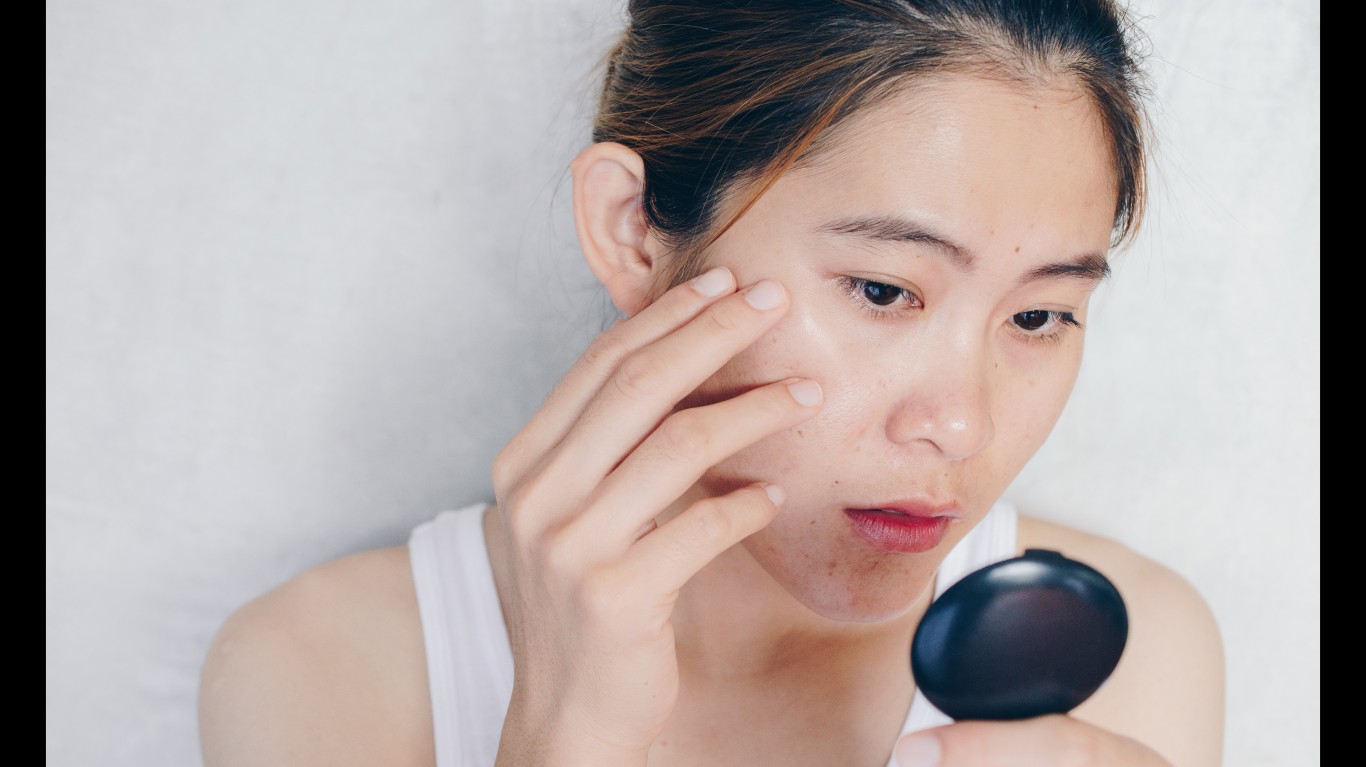
34. Beware of allergic reactions
Hives and runny nose are common signs of an allergic reaction, but some are much lesser known. Dark circles under the eyes, for example, may indicate an allergy. Known as allergic shiners, people often think they are just aging or perhaps not getting enough sleep, said Dr. Tania Elliott, spokesperson for the American College of Allergy, Asthma, and Immunology. “The truth is blood vessels under the skin dilate in the setting of allergic reactions, and because the skin under the eyes is so thin, you see the result of that dilation in the form of dark circles.” This is just one reason why dark circles under the eyes should not be ignored.
[in-text-ad-2]

35. Know what increases risk of stroke in women
Heart disease is the No. 1 killer of both men and women in the United States, and more women have a stroke every year than men. Stroke risks in women are different because of hormones, reproductive health, pregnancy, and childbirth. For example, a history of eclampsia or preeclampsia doubles the risk of stroke within five to 15 years. Women with high blood pressure should avoid birth control pills because they can also increase the risk of stroke even more. Other factors that may increase the risk of stroke, and that are also more common in women, include irregular heartbeat, depression, diabetes, and emotional stress.

36. Recognize the signs of stroke
Stroke is the third-biggest killer of women in the United States (and the fifth-biggest in men). About 55,000 more women than men have a stroke every year, according to the National Stroke Association. Some signs are common among both sexes, such as sudden confusion and numbness in the face, vision problems in one or both eyes, as well as loss of coordination. But some symptoms are unique to women. They include vomiting, hallucinations, shortness of breath, disorientation, and hiccups. Taking birth control pills or being pregnant may increase the risk of stroke. What has once been thought to increase the risk of stroke were eggs and cholesterol, but now a new study says that may not be true.
[in-text-ad]

37. Never use tanning beds again
About 7.8 million adult women and 1.9 million adult men in the United States tan indoors. A 2017 study found that one in five white women who tan indoors get addicted. Dermatologists warn it’s better to never use tanning beds. Tanning is significantly linked to the development of all skin cancers, including melanoma, which can be deadly, according to Richmond. “I am seeing much more melanoma and basal cell carcinoma in young women as early as their 20s and 30s who have a history of tanning.” In addition to increasing the risk of skin cancer, tanning dramatically accelerates aging of the skin, resulting in earlier wrinkles, uneven skin tone, persistent redness, and brown spots, she added.

38. Recognize symptoms of UTIs
Urinary tract infections are more common among women than men because women have shorter urethras — bacteria don’t need to travel as far to reach the bladder. UTIs can be painful but are not generally dangerous, unless left untreated, in which case they can reach the kidneys and cause permanent damage. Symptoms include a burning sensation when urinating, urine with a strong smell, pelvic pain, and frequently having to go to the bathroom. These are just some of the signs people always ignore but never should.

39. ‘Feed’ your skin
Skin care is not all about what you put on the skin; your diet is a major factor too. Richmond, recommends eating a diet with foods containing omega-3 fatty acids, vitamin E, vitamin C, vitamin A, zinc, and a variety of antioxidants. These can be found in fish, nuts and seeds, avocados, and more. Avoiding foods with high sugar content has been shown to prevent some breakouts such as acne.
[in-text-ad-2]

40. Don’t take long, hot showers
Hot water and long showers contribute to drying of the skin. In the winter, people are naturally prone to dryer skin because environmental humidity is low. Hot water, although it feels good when it’s cold out, further dries out the skin. That’s why Dr. Jason Miller of Schweiger Dermatology Group in New Jersey recommends lukewarm water and shorter showers during the winter.
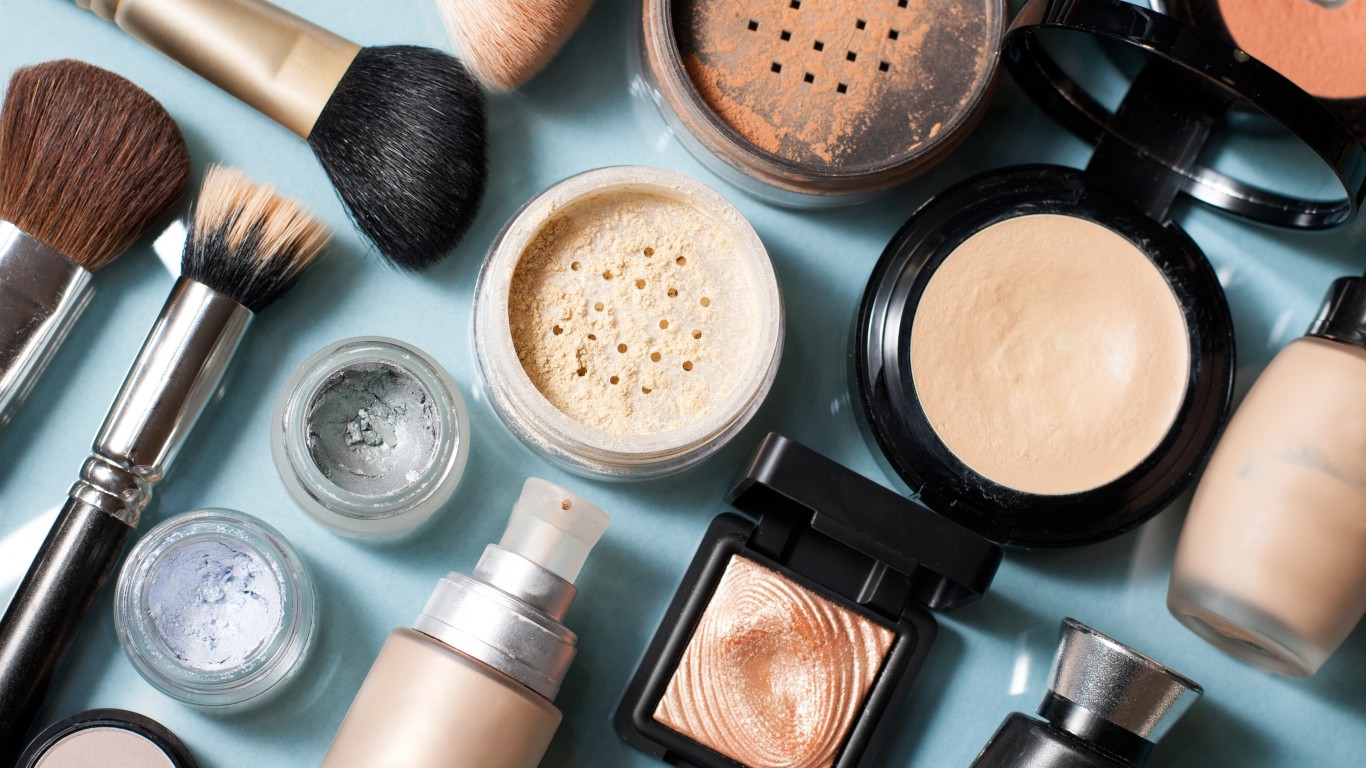
41. Get rid of expired skin care products
“Expired skin care products should not be used,” Richmond said. The chemical ingredients will break down over time and lose efficacy, she added. Also, the risk of bacterial contamination in expired products is not worth it, according to Miller.
[in-text-ad]

42. Try sleeping on your back more
About 41% of people sleep in the so-called fetal position — on their side with their legs curled up, according to the National Sleep Foundation. It’s a very common position, but there is one problem with it. “People commonly have deeper wrinkles on the side of their face that they sleep on if they are side or stomach sleepers,” Richmond said. This is a result of pressure over time. Sleeping on your back is the best position, the National Sleep Foundations says, because your head, neck, and spine rest in a neutral position. Sleeping is crucial for maintaining good health, and these are some tips on what you can do to get a better night’s sleep.
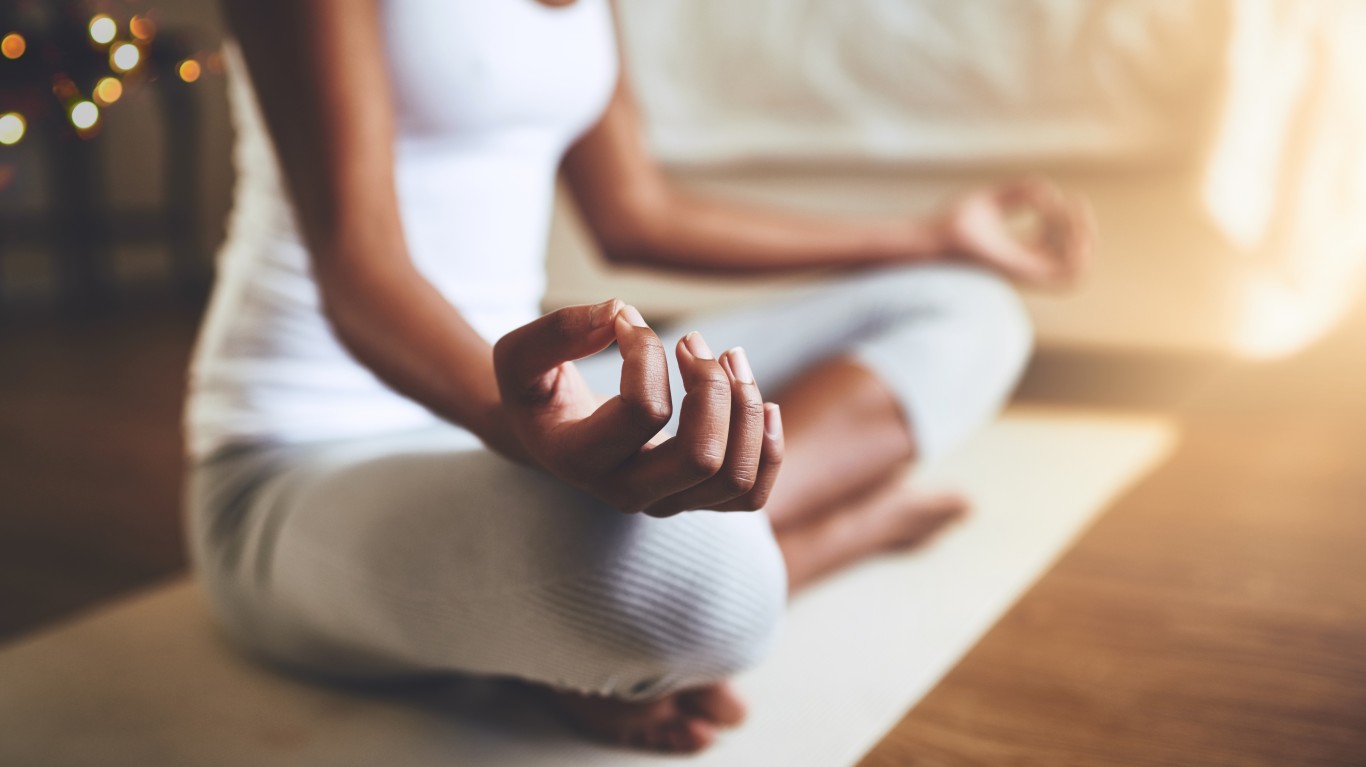
43. Do gentle activity to help with menopause symptoms
Menopause is a natural decline in women’s reproductive hormones that often coincides with many unpleasant side effects. It starts at a different age for different women, usually in their 40s or 50s. Some common side effects include hot flashes, trouble sleeping, moodiness, and irritability. Though there is no evidence that these can help, some women may find relief from the symptoms by engaging in some gentle physical activity such as yoga and tai chi. Symptoms may also include muscle and joint pain, according to the U.S. Department of Health and Human Services.

44. Take iodine deficiency seriously
Lack of iodine, a chemical element the body needs — most notably for proper thyroid function — but is not able to make itself, is the most preventable cause of mental retardation in the world, according to the CDC. Women between 20 and 39 years old have the lowest urine iodine levels compared with all other age groups. They should pay special attention to iodine levels during pregnancy for brain development of the fetus. A sign you may have a thyroid dysfunction is drinking a lot of coffee in the afternoon. This is just one of several habits that may be a symptom of a serious health problem.
[in-text-ad-2]

45. Get a full skin exam at least once a year
Skin cancer is by far the most common type of cancer and can affect all ages and all skin types. “It is very common that when a patient comes in for a full skin exam, the spot or spots they are concerned about are completely healthy, but I find something else that they haven’t even noticed that turns out to be a skin cancer or abnormal mole,” said Richmond. In women, melanoma, the most serious type of skin cancer, most often develops on the lower legs. (These are the most common types of cancer in men and women.)

46. Quit smoking
While more men than women smoke, there is a big difference in the reasons each gender smokes. Men do it for the reinforcing effects of nicotine, while women do it to regulate mood, according to the National Institutes on Drug Abuse. “There is no level of smoking that’s good. Period. There is no such thing as ‘but I smoke only a few days a week,'” Dr. Alfred Casale, associate chief medical officer for Geisinger and chair of the Geisinger Heart Institute. The ill effects of smoking are well established and include increased risk of several cancers, including cancers of the lung, mouth, throat, and esophagus. Smoking also increases the risk of heart attack, emphysema and chronic breathing problems.
[in-text-ad]

47. Stretch
Stretch classes were a popular exercise fad a few decades ago. But while such classes may not be necessary, stretching is. Stretching is important not just after a workout but also regularly because otherwise muscles go into a contracted state from sitting. Contracted muscles lead to cells aging faster, which eventually leads to wrinkles. Women who wear high heels should stretch the plantar fascia and calves especially often in order to avoid injury. High heels put the foot on an angle, pulling muscles and joints out of proper alignment, eventually leading to pain, not just in the feet, but in the neck and shoulders as well.

48. Accept cellulite
Cellulite, or fat deposits underneath the skin, causes a dimpling of the skin, especially around women’s hips and thighs. Up to 90% of all women could experience cellulite, which is more common in women because of how fat is distributed in the female body. There are many different ways that are being tried to treat the condition, but there is not a single one that can be called a cure. Some work for some women, and to a different degree. In general, weight loss and exercise help at least improve the appearance of cellulite.

49. About supplements
More than half of all Americans take supplements. In order for the body to function properly, it needs many nutrients, which it gets from a well-balanced diet. If your body lacks certain vitamins, you may have to take supplements, but not without talking to your doctor first. A rule of thumb is to take, if you have to, one multivitamin a day, no more. And whether they actually help is not certain as studies have provided little to no evidence of protection against illnesses. In fact, a recent study has shown that a common ingredient in many supplements is dangerous for pregnant women.
[in-text-ad-2]

50. Take care of your gut
The gut is important because it plays a key role in overall health. Early research suggests it may help lower the risk and help treat some diseases, including cancer, arthritis, and heart conditions. A recent study has suggested that being a man or a woman may play a role in gut health. There seems to be “a sex-dependent effect on shaping the gut microbiota according to diet.” HIgher levels of certain bacteria were observed in women. The trillions of microbes that live in our gut have an important role, often helping to keep us healthy — and these are the best foods for your gut health.
Are you ahead, or behind on retirement? For families with more than $500,000 saved for retirement, finding a financial advisor who puts your interest first can be the difference, and today it’s easier than ever. SmartAsset’s free tool matches you with up to three fiduciary financial advisors who serve your area in minutes. Each advisor has been carefully vetted and must act in your best interests. Start your search now.
If you’ve saved and built a substantial nest egg for you and your family, don’t delay; get started right here and help your retirement dreams become a retirement reality.
Thank you for reading! Have some feedback for us?
Contact the 24/7 Wall St. editorial team.